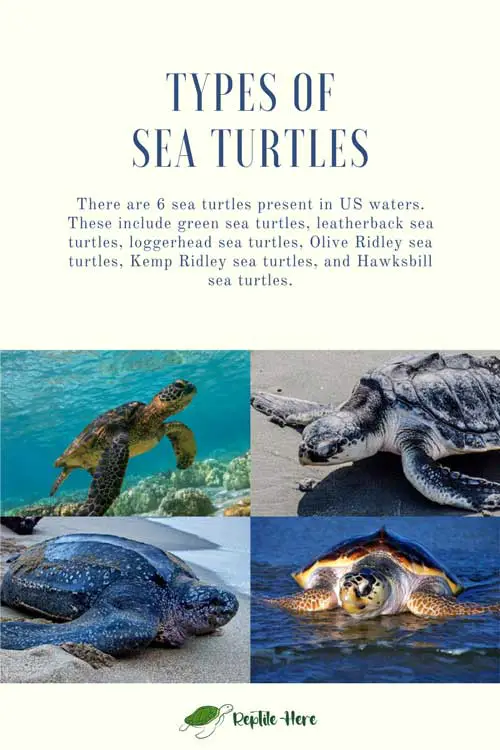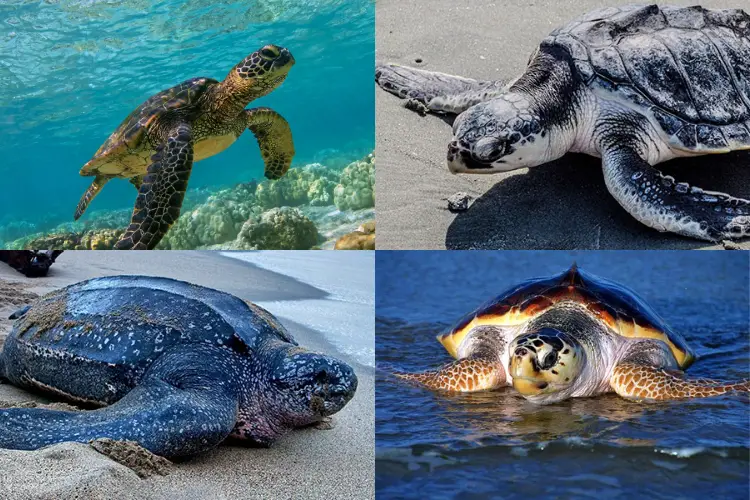Types of Sea Turtles
There are 6 sea turtles present in US waters. These include green sea turtles, leatherback sea turtles, loggerhead sea turtles, Olive Ridley sea turtles, Kemp Ridley sea turtles, and Hawksbill sea turtles.
Leatherback turtle sets themselves from the other species with their leathery shell while their relatives have hard shells similar to most of the other turtle species.
Unfortunately, all these marine turtles are listed by IUCN Red List as endangered (some are critically endangered!).
They face multiple threats in the wild such as marine pollution costly development, poaching and overharvesting, and accidental capture as bycatches in fishing gear.
Find more details below about sea turtles that reside in the oceans of the United States. For each turtle, we’ll discuss basics such as physical appearance, average adult size, habitat, diet, and more.
1. Green Sea Turtle
Contents
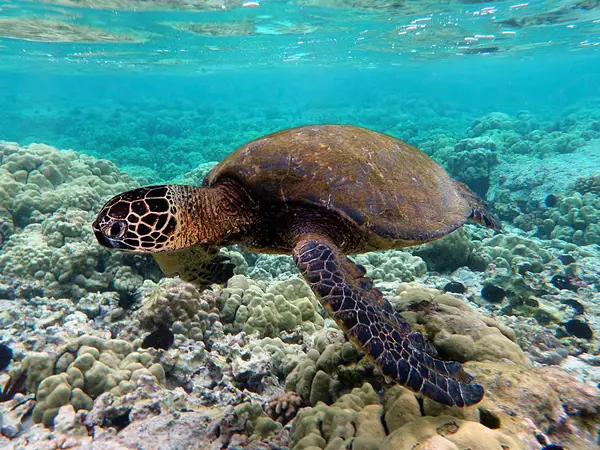
- Scientific name: Chelonia mydas
- Common name: Green turtle, Pacific green turtle, Black sea turtle
- Family: Cheloniidae
- Size: 2 to 5 feet
- Lifespan: 60 to 70 years
- Conservation status: Endangered
The green sea turtle species is classified among the largest hard-shelled sea turtles in the US and is common in states like Texas, Washington, Virginia, South Carolina, Hawaii, Florida, North Carolina, Alabama, and Alaska, among others.
This species is characterized by scutes that run down the middle; they’re 4 on each side. The shell color can be gray, dark brown, or olive with a yellow-to-white bottom shell or plastron.
It also features a serrated beak on its lower jaw and two large scales resign between the eyes.
Males are generally larger than females and have longer tails. The females lay their eggs on the beach and use their paddle-shaped flippers to easily burrow in the sand when laying eggs. A single green turtle can lay up to 200 eggs!
This sea turtle species gets its name from its primary diet which consists of age and seagrasses (mind you, this diet is responsible for tinting its cartilage green).
Green turtles are usually found in tropical as well as subtropical waters throughout the years. They also tend to migrate to cooler temperatures and even boreal waters when the weather gets warmer.
2. Loggerhead Sea Turtle
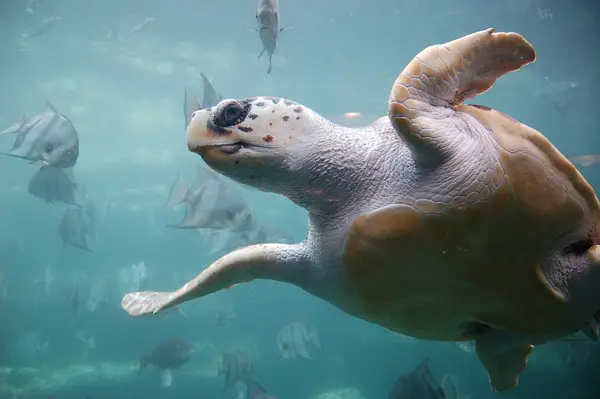
- Scientific name: Caretta caretta
- Common name: Loggerhead, Loggerhead Sea-Turtle
- Family: Cheloniidae
- Size: 3.5 feet
- Lifespan: 70+ years
- Conservation status: Endangered
Loggerhead sea turtles boast their place as the most abundant sea turtle species in the United States and are found in many states, including Alabama. Rhode Island, Florida, Texas, Washington, North Carolina, New Jersey, Oregon, and Virginia.
These turtles are pretty big and can reach up to 3.5ft in length. They weigh up to 350 pounds and can live for a whopping 70 years or more.
A loggerhead is distinguished by a slightly heart-shaped carapace that’s reddish brown in color, with pale yellow plastron. Some species also feature yellow-bordered scutes.
This turtle species gets its name from its large head. It has powerful jaws that enable it to feed on a variety of foods including conch, whelks, insects, jellyfish, gastropods, and algae.
The loggerhead turtles are usually found in temperate, tropical, and subtropical waters all year round. However, they also tend to migrate to cold boreal waters on rare occasions, for instance, during El Nino weather.
3. Leatherback Sea Turtle
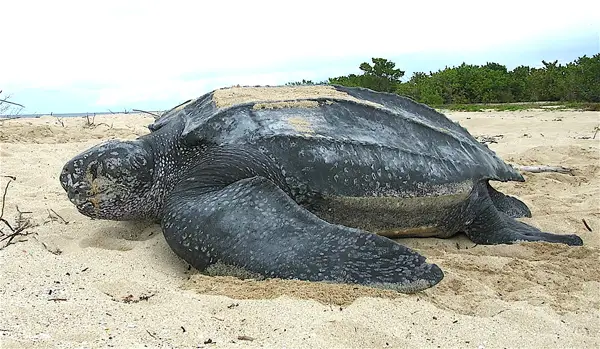
- Scientific name: Dermochelys coriacea
- Common name: leathery turtle, trunk turtle, Lute turtle, luth
- Family: Dermochelyidae
- Size: 5 to 6 feet
- Lifespan: 50+ years
- Conservation status: Vulnerable
The leatherback sea turtles are also found in multiple US states including Alabama, Rhode Island, North Carolina, Washington, South Carolina, Virginia, Florida, Massachusetts, Mississippi, and Connecticut.
These turtles are known to grow to mammoth sizes (up to 6 feet!). An average adult can also weigh as heavy as 540lbs!
Leatherback turtles usually have black shells. And they differ from other species of turtles with their smooth leathery carapace and skin. Their upper shell is made up of a flexible layer of dermal bones covered by tough and oily connective tissue and smooth skin.
The body of this turtle is barrel-shaped and then tapered to the rear. They have a total of 7 longitudinal dorsal ridges and their whole body is almost completely black, with some variable spotting.
Leatherback turtles have tooth-like cusps that work closely with their sharp-edged jaws to enable them to easily feed on jellyfish, salps, and other gelatinous zooplankton.
As for the habitat, these turtles are fond of tropical and subtropical waters all year round. But they tend to migrate to cooler, temperate, and boreal waters during warm weather.
Note that this species is highly migratory and can swim as many as 10,000 miles in a year between foraging and nesting grounds. They’re also excellent divers—with the deepest diving record standing at whopping 4,000 feet!
4. Kemp’s Ridley Sea Turtle
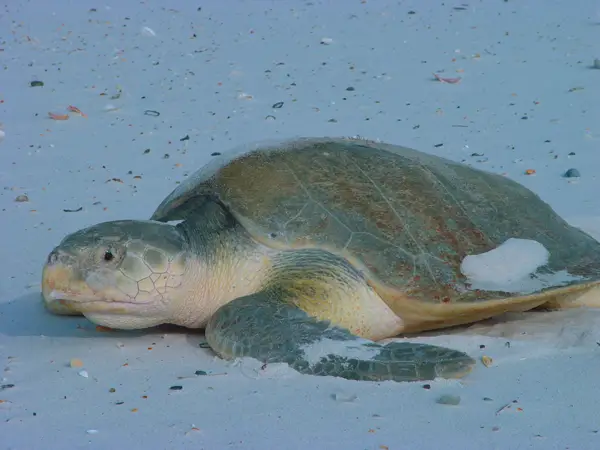
- Scientific name: Lepidochelys kempi
- Common name: Atlantic ridley sea turtle,
- Family: Cheloniidae
- Size: 2+ feet
- Lifespan: 30+ years
- Conservation status: Critically endangered
Kemp’s ridley sea turtle is the smallest species of all the sea turtles in the US and is found in states like Rhode Island, North Carolina, South Carolina, Texas, Mississippi, Virginia, and New Jersey, among others.
The average adult size is about 2 feet and weighs approx. 110 lbs. They have adapted flippers (front limbs) and a beak.
This turtle is the rarest sea turtle species and is one of the world’s most endangered species. The species is called Kemp’s ridley because Richard Moore Kemp of Key West was the first to send its specimen to Samuel Garman at Harvard university. However, the origin of the name ridley is still unclear.
Note that these turtles tend to change their color as they age. Baby turtles feature dark purple color along the sides which turns into yellow-green as they mature.
Kemp Ridley is also the only sea turtle that nests during the day.
These turtles also practice Arribada nesting, which involves all the females nesting together in a tight group. This helps them protect themselves better from predators as well as help their hatchlings easily make it to the open ocean.
5. Olive Ridley Sea Turtle
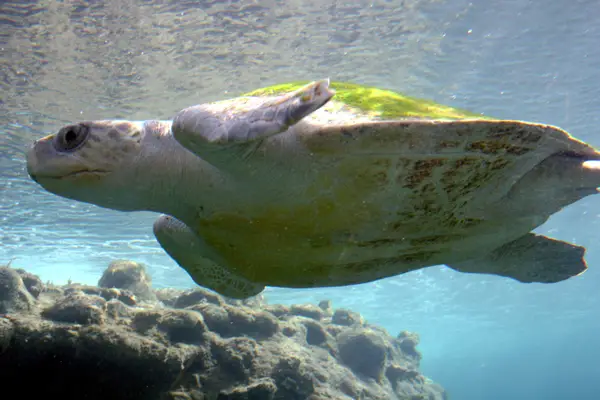
- Scientific name: Lepidochelys olivacea
- Common name: Pacific ridley sea turtle
- Family: Cheloniidae
- Size: 2.5 feet
- Lifespan: 50 years
- Conservation status: Vulnerable
Olive ridley sea turtles are present in Hawaii, Alaska, California, Oregon, and Washington.
These sea turtles are much smaller than other species of sea turtles. They reach a maximum of 2.5 feet in length and weigh up to 100 pounds. And they have an average lifespan of up to 50 years.
An olive ridley sea turtle has a heart-shaped carapace with olive to grayish-green in color. The shell features around 5 to 9 scutes. These turtles are generally omnivorous and feed on crustaceans, fish, jellyfish, mollusks, algae, and salps.
These sea turtles can opt to nest in large groups or by themselves. In the event of a mass nesting, the female turtles usually gather in large groups offshore on the nesting beaches.
This is then followed by a vast number of turtles moving ashore to nest (this event is usually referred to as arribada, a Spanish word for arrival).
The arribada is marked by numerous (hundreds of thousands) pregnant females coming ashore to lay eggs. Due to the high density of nesting experienced at the nesting beaches, the females end up digging up clutches of eggs laid by other females as they try to find a place for their eggs.
Olive ridley turtles are usually found in tropical and subtropical waters all year round. Though they tend to migrate to boreal waters when the climate gets warmer.
6. Hawksbill Sea Turtle
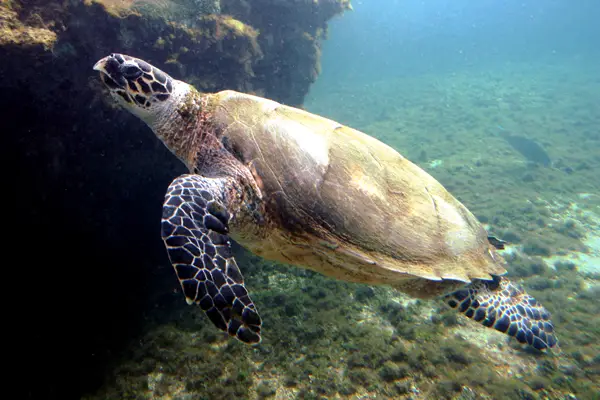
- Scientific name: Eretmochelys imbricata
- Common name: hawksbill turtle
- Family: Cheloniidae
- Size: 2.5 to 3 feet
- Lifespan: 50 to 60 years
- Conservation status: Critically endangered
Hawksbill sea turtles have been found in many states including Maryland, Alabama, Virginia, North Carolina, Hawaii, Massachusetts, Maryland, Texas, Florida, and South Carolina.
The adult has an average size of 3 feet and weighs around 180 pounds. The shell of this turtle features amber upper shell with irregular light and dark streaks. They also feature predominant black and molten brown easily radiating to the sides.
The shell tends to change color depending on the water temperatures.
This colored and patterned shell makes this turtle highly valuable and is commonly sold as “tortoiseshell” in the markets.
The hawkbill turtle is so named due to its narrow, pointed beak. It also has a distinctive pattern of overlapping scales on its shells which form a serrated look on the edges.
These turtles mainly feed on the sponge which they easily extract from reef crevices with the help of their narrow, pointed beaks. They also feed on jellyfish.
Hawkbill turtles are generally found in tropical oceans throughout the world. While they live in the open ocean, they tend to spend more time in various coral reefs and shallow lagoons across the US.
During nesting, a female hawkbill turtle will look for small coves, “pocket” beaches, or inlets surrounded by rocks. They tend to travel high up the beach to lay eggs in shelters formed by the plants.
Conclusion
The sea turtles inhabiting the United States waters are green sea turtles, leatherback sea turtles, loggerhead sea turtles, Olive Ridley sea turtles, Kemp Ridley sea turtles, and Hawksbill sea turtles.
In this guide, we have shared the basics you need to know about each of them from their physical appearance, their preferred habitats in the oceans, average adult sizes and weights, and conservation statuses as listed by IUCN.
As you have noted from this list, the Kemps Ridley and hawksbill sea turtles are listed as critically endangered turtles due to the threats they face, including habitat loss, causing their numbers to decline pretty fast.
The other sea turtles aren’t lucky as they’re also listed as endangered or vulnerable and they also face similar threats.
